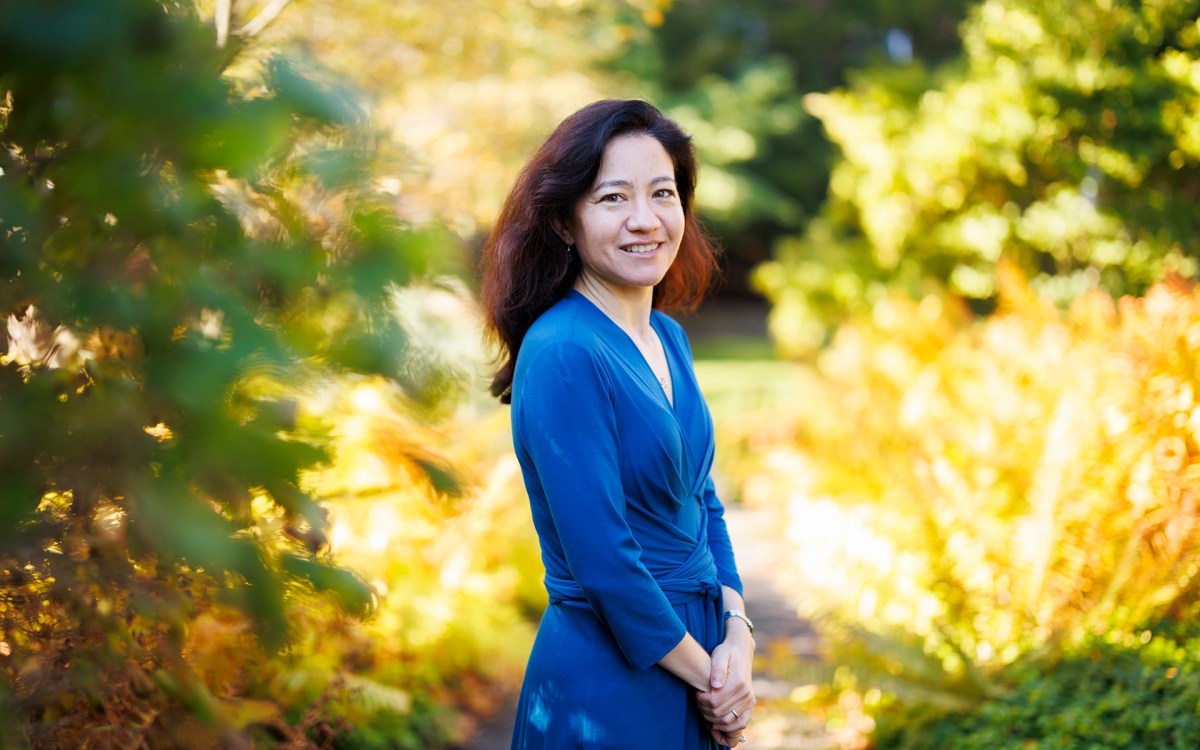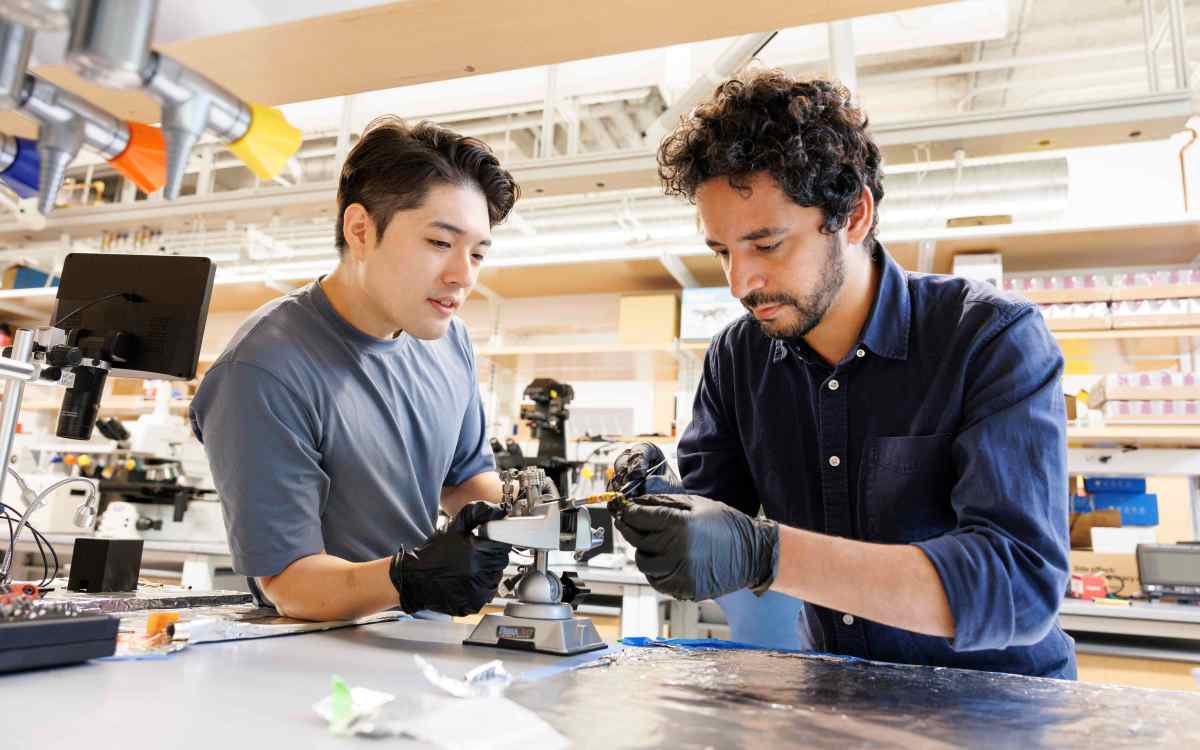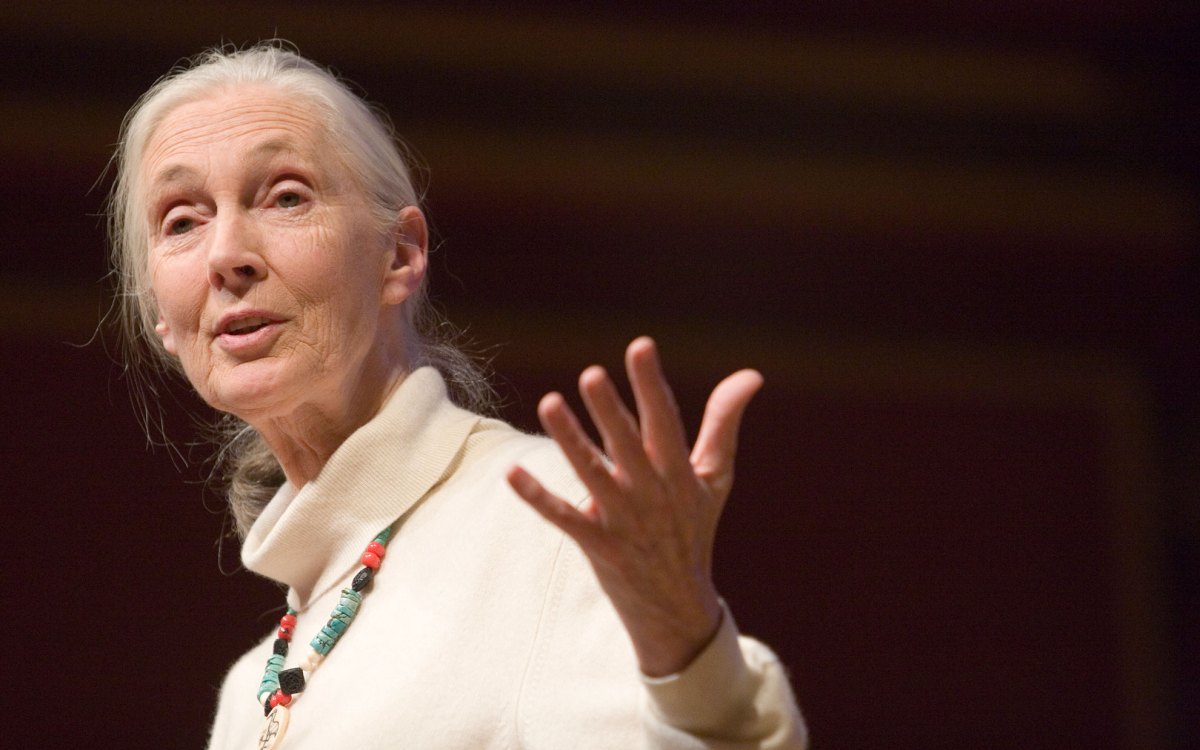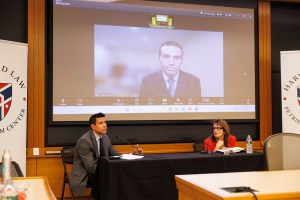Science & Tech
-

Harsh past might bare its teeth
Early adversity leads to higher aggression and fearfulness in adult canines, study says

-

What will AI mean for humanity?
Scholars from range of disciplines see red flags, possibilities ahead
-

‘Human exceptionalism is at the root of the ecological crisis’
Saving the planet requires getting over ourselves, argues author of ‘The Arrogant Ape’
-

Lauren Williams awarded MacArthur ‘genius grant’
Math professor honored for theoretical breakthroughs with sometimes surprising applications across phenomena such as tsunamis, traffic
-

-

‘She had a sense of caring for everybody that she encountered.’
Richard Wrangham remembers his teacher and colleague Jane Goodall as a force of science, empathy, and hope
-
Mystery comet explodes into brightness
A once-faint comet has made a sudden leap from obscurity tocenter stage. Comet 17P Holmes, now visible to northern hemisphereresidents, increased its brightness by a factor of one million this…
-
Over the river, through the woods
For close to 30 Hyde Park preschool children, a recent trip to the Arnold Arboretum, the majestic 265-acre botanical garden run by Harvard University in Jamaica Plain, meant a journey to a world alive with natural wonders and surprises.
-
Redheaded strangers
Ancient DNA retrieved from the bones of two Neanderthals suggests that at least some of them had red hair and pale skin, scientists report this week in the journal Science.…
-
Harvard science depth, breadth is on display
Five prominent Harvard scientists illuminated the cutting edge of Harvard science, predicting new treatments for old diseases, describing new ways to think about the universe, and hailing advances in our…
-
Forests, reefs, mountaintop illuminate tropical biology
Morning came in the middle of the night in the hikers’ hut partway up the side of Borneo’s towering Mount Kinabalu. At 2 a.m., after just a few hours’ sleep,…
-
Basic understanding of biological clock advances
Writing this week in the journal Science, researchers at Harvard describe what causes a trio of proteins, if placed in a test tube with the common biochemical fuel ATP as…
-
Frankel wins Lennart Nilsson Award
Felice Frankel, scientific imagist and Senior Research Fellow at Harvard’s Initiative in Innovative Computing, has been named the recipient of the 2007 Lennart Nilsson Award for scientific or nature photography.…
-
Nanowire generates its own electricity
Harvard chemists have built a new wire out of photosensitive materials that is hundreds of times smaller than a human hair. The wire not only carries electricity to be used…
-
Yale honors E. O. Wilson with Verrill Medal
Yale honors Wilson with Verrill Medal Pellegrino University Professor Emeritus E.O. Wilson received the Addison Emery Verrill Medal from Yale’s Peabody Museum of Natural History on Wednesday (Oct. 17)…
-
Survey of hurricane preparedness finds one-third on high risk coast will refuse evacuation order
Thirty-one percent of residents surveyed in coastal areas said they wouldn’t evacuate in the face of a major hurricane, even if told to do so by the government, according to…
-
From overviews of landscapes to inner views of cells
The photographs are stunning abstracts that look as though they should be hung above a mantle or in a fine art gallery. But these aren’t primarily works of art; they…
-
Tracking down the seat of moral reasoning
Moral philosophers have long grappled with ethical questions, creating hypotheticals that test basic beliefs about right and wrong. For example: A trolley is running down a track out of control.…
-
Harvard brings the Earth to high school
Steam vents in Yellowstone National Park are part of the area’s unique environment, seen in a case study exploring Yellowstone and the reintroduction of wolves into the park. This case study is part of a new environmental science course for high school science teachers.
-
Do sports and statistics constitute a ‘dream team’?
Many argue it’s the reason the curse was finally reversed. A few say it has revolutionized the game. “Sabermetrics” — the statistical analysis of baseball data — pervades sports conversation today. But how many people are aware that analytical statistics can make powerful contributions to other sports, like say, pingpong? Well, for a start there are the more than 100 statisticians and sports enthusiasts — in this case, often one and the same — who came together at the Harvard University Science Center Sept. 29 for the first “New England Symposium on Statistics in Sports” (NESSIS).
-
Ancient practice sans theory
Move over, Archimedes. A researcher at Harvard University is finding that ancient Greek craftsmen were able to engineer sophisticated machines without necessarily understanding the mathematical theory behind their construction.
-
Colorizing classic statues returns them to antiquity
For artists of the Renaissance, the key to truth and beauty lay in the past. Renaissance artists assiduously studied the sculptures and monuments of Greece and Rome and emulated them…
-
Digging for solutions to energy crisis
In the 1970s, Iceland was one of the poorest countries in Europe. Today it is one of the richest, with a per capita GDP higher than that of Denmark, from which it won full independence in 1944.
-
Male voice pitch predicts reproductive success in hunter-gatherers
Deeper voice pitch predicts reproductive success in male hunter-gatherers, according to a new study from researchers with Harvard University, McMaster University, and Florida State University. This is the first study…
-
‘Hot’ ice could lead to medical device
Harvard physicists have shown that specially treated diamond coatings can keep water frozen at body temperature, a finding that may have applications in future medical implants.
-
CfA reveals Magellanic Clouds are first-time visitors
The Large Magellanic Cloud (LMC) and Small Magellanic Cloud (SMC) are two of the Milky Way’s closest neighboring galaxies. A stunning sight in the southern hemisphere, they were named after the Portuguese explorer Ferdinand Magellan, who explored those waters in the 16th century. For hundreds of years, these galaxies were considered satellites of the Milky Way, gravitationally bound to our home galaxy. But new research by Gurtina Besla of the Harvard-Smithsonian Center for Astrophysics (CfA) and her colleagues shows that the Magellanic Clouds are recent arrivals — on their first visit to the Milky Way’s neighborhood.
-
Biohybrid of elastic film and muscle cells packs a punch
In an innovative marriage of living cells and a synthetic substrate, bioengineers at Harvard University have found that a rubberlike, elastic film coated with a single layer of cardiac muscle cells can semi-autonomously engage in lifelike gripping, pumping, walking, and swimming.
-
Creating a computer currency
Computer scientists are using the latest version of peer-to-peer video sharing software to explore a next-generation electronic commerce model that uses bandwidth as a global currency.
-
Harvard astronomers share dark prize
Two teams who upset everyone’s ideas about how the universe works and its future will share the $500,000 Gruber Cosmology Prize for discovering that 70 percent of the universe is nothing but a strange form of energy.
-
Harvard launches major initiative to help design international climate agreements
Harvard University announced in early July a two-year project to help identify key design elements of a future international agreement on climate change, drawing on the ideas of leading thinkers from academia, private industry, government, and advocacy organizations, both in the industrialized world and in developing countries.
-
Oceans are back on Mars
Since spacecraft sent back the first close-up images of Mars more than 30 years ago, some experts have insisted that oceans once existed on the now dry, cold planet. Critics have maintained for decades that such an idea is the product of unrestrained imaginations. Now, a study published in today’s (June 14) issue of the British journal Nature reports new evidence that our neighbor in space once boasted an ocean or oceans as big, relative to planet size, as the Atlantic on Earth.
-
Rajan Sonik hopes to cure bodies while energizing hearts and souls
Rajan Sonik arrived at Harvard four years ago aspiring to a career in science or maybe law, but a 14-year-old boy with sickle cell disease Sonik met in his sophomore year through a hospital mentoring program changed everything.
-
Single spinning nuclei in diamond offer a stable quantum computing building block
Surmounting several distinct hurdles to quantum computing, physicists at Harvard University have found that individual carbon-13 atoms in a diamond lattice can be manipulated with extraordinary precision to create stable quantum mechanical memory and a small quantum processor, also known as a quantum register, operating at room temperature. The finding brings the futuristic technology of quantum information systems into the realm of solid-state materials under ordinary conditions.
-
‘Digital immigrants’ teaching ‘digital natives’
Students coming into universities today are ‘digital natives’ and fundamentally different in their use of technology than the ‘digital immigrants’ who teach them, according to John Palfrey, executive director of…
-
Center for Environment announces new fellows
From Sri Lankan tree frogs and Australian algae to the grasslands of East Africa, the research topics of the latest group of Harvard University Center for the Environment (HUCE) Environmental Fellows represent their diverse backgrounds. The five fellows — from five different countries — will begin their work this September, joining the five fellows from the program’s inaugural group (two of the first seven fellows, Peter Huybers and Valeriy Ivanov, left the program early for faculty positions at Harvard and the University of Michigan, respectively).
-
Making days longer than 24 hours
People at a research hospital in Boston have been living 24-hour, 39-minute days. They were part of an experiment to show that the 24-hour human sleep-wake cycle can be adapted to other biological rhythms like the longer days on Mars.


